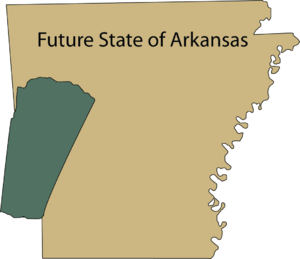Treaty of Washington City facts for kids
The Treaty of Washington City was an important agreement. It was signed on January 20, 1825. This treaty was between the Choctaw people and the United States government. The Choctaw are a Native American tribe.
Contents
Choctaw Leaders Visit Washington
In 1824, important Choctaw leaders traveled to Washington City. This city is now known as Washington, D.C.. The leaders were Apuckshunubbee, Pushmataha, and Mosholatubbee. They went to talk about settlers moving onto their land. The Choctaw wanted these settlers to leave. They also wanted money for their land.
Other people joined the group. These included Talking Warrior, Red Fort, and Nittahkachee. Col. Robert Cole and David Folsom also came. They were of mixed Choctaw and European heritage. Captain Daniel McCurtain and Major John Pitchlynn, a U.S. Interpreter, were also part of the group.
The journey to Washington was long. They traveled through many states. They went from Natchez to Nashville, Tennessee. Then they went to Lexington, Kentucky. After that, they crossed the Ohio River. Finally, they traveled east to Washington City.
Important Meetings in Washington
While in Washington, Pushmataha met with President James Monroe. He also spoke to Secretary of War John C. Calhoun. Pushmataha reminded them of the long friendship. He said the Choctaw had always been allies of the United States.
Pushmataha told them, "No Choctaw ever fought against the United States." He also explained their problem. "My nation has given away so much land. Our country is now very small. We are in trouble."
During his visit, Pushmataha had his portrait painted. The artist was Charles Bird King. The painting showed Pushmataha in his Army uniform. It was displayed in the Smithsonian Institution.
Pushmataha also met with the Marquis de Lafayette. Lafayette was a French hero. He had helped the United States in its early days. Pushmataha told him, "Almost fifty years have passed. You fought with George Washington. Our hearts have wanted to see you."
Key Points of the Treaty

The treaty began by stating its purpose. It was an agreement between John C. Calhoun, the Secretary of War. He represented the United States. The Choctaw Chiefs and Head Men represented their Nation. They met in Washington City on January 20, 1825.
Here are the main points of the treaty:
- The Choctaw gave some of their lands to the United States.
- The United States agreed to pay the Choctaw $6,000 every year, forever.
- The United States also agreed to pay them another $6,000 each year for 16 years.
- The treaty made plans for Choctaw people. These were for those who wanted to stay on their old lands.
- A certain debt owed by the Choctaw was forgiven.
- The Choctaw received payment for their help. This was for their service in the Pensacola campaign.
- An earlier treaty was changed. The U.S. Congress could not divide Choctaw lands. They could not make Choctaw lands follow U.S. laws. This could only happen if the Choctaw Nation agreed.
- The United States agreed to pay for claims. These were debts owed by the U.S. to the Choctaw.
- The Choctaw living west of the Mississippi River would get an agent. They would also get a blacksmith.
- Robert Cole was to receive a special medal.
- The friendship between the two groups would continue.
- The treaty would become active at a certain time.
Who Signed the Treaty?
The treaty was signed by J. C. Calhoun for the United States. The Choctaw leaders who signed were Mooshulatubbee, Robert Cole, Daniel McCurtain, Talking Warrior, Red Fort, Nittuckachee, and David Folsom. Other signers included J. L. McDonald, Thos. L. McKenney, Hezekiah Miller, and John Pitchlynn, the U.S. interpreter.
What Happened Next?
Sadly, two of the Choctaw leaders died soon after the treaty. Apuckshunubbee died in Maysville, Kentucky. Pushmataha died in Washington.
Reports said Apuckshunubbee died from a fall. He fell from a hotel balcony. Other stories say he fell from a cliff. He was badly hurt and died a few days later.
Pushmataha died from a sickness called croup. This disease usually affects very young children.
After Apuckshunubbee's death, Robert Cole became a leader. Later, Greenwood LeFlore took over. Nittakechi became the leader after Pushmataha. The deaths of these two important leaders weakened the Choctaw Nation. Within six years, the Choctaw were forced to give up their last lands in Mississippi to the United States.



